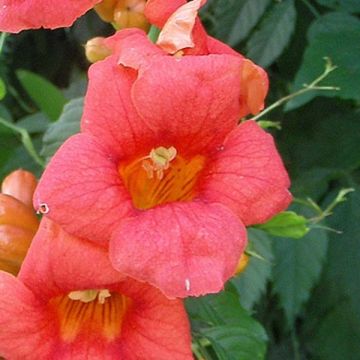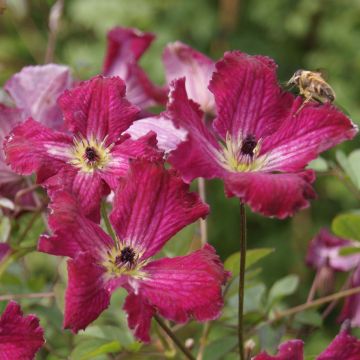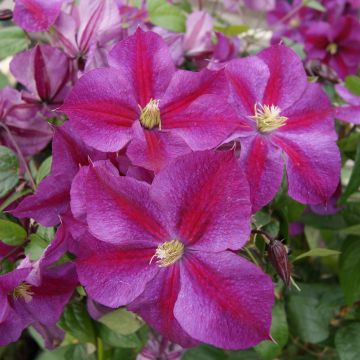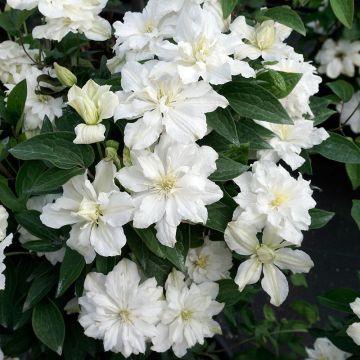

Pandorea jasminoïdes Rosa - Bignone faux jasmin


Pandorea jasminoïdes Rosa - Bignone faux jasmin
Pandorea jasminoïdes Rosea - Bower Vine
Pandorea jasminoïdes Rosea
Bower Vine, Jasmine Pandorea
This item cannot be shipped to the selected country
Delivery charge from €5.90
More information
Schedule delivery date,
and select date in basket
This plant carries a 6 months recovery warranty
More information
We guarantee the quality of our plants for a full growing cycle, and will replace at our expense any plant that fails to recover under normal climatic and planting conditions.
From €5.90 for pickup delivery and €6.90 for home delivery
Express home delivery from €8.90.

Does this plant fit my garden?
Set up your Plantfit profile →
Description
The Pandorea jasminoides 'Rosea' with its delightful pink flowers is a delightful form of the wonderful False Jasmine Bower Vine, a magnificent climbing plant that is frost-tender and best suited for the warmest areas of our country when grown in the ground. It is a vigorous cousin of our trumpet vines, and its long summer flowering is enhanced by lush foliage of a very bright green. It blooms generously, displaying beautiful clusters of funnel-shaped flowers. While its cold tolerance is very limited, this vine thrives in any fertile and well-drained soil, as long as it is provided with the necessary sunlight to bloom well. It is also a superb plant for adorning the terrace, as it can be easily grown in a container and stored during winter.
The Pandorea jasmin is a species of the Bignonia family. It is native to Southeast Australia, specifically the sclerophyll forests, which are rather dry, found in this region governed by a humid tropical climate. It is a liana with a woody base and strong twining branches that lack a support system, naturally wrapping around a support. It grows rapidly and can reach 6 to 8 m (20 to 26ft) in all directions in favorable conditions, when planted in the ground. In a container, its growth will be more modest. The vegetation is destroyed at -0°C (32°F), but a well-established base protected by a thick mulch can survive short freezes of around -5°C (23°F): it is a plant suitable for planting in the ground in zones 9b, 10, and beyond.
The flowering occurs from May-June to September. The flowers bloom at the ends of the year's shoots and in the axils of the leaves, grouped in ramified clusters. They have widely flared trumpet-shaped flowers, 6-8 cm (2-3in) long and wide. Each flower consists of a tube widening into 5 rounded and undulate lobes. Their colour is a lovely fresh pink, enhanced by a slightly darker pink throat. This lightly scented flowering is nectar-rich and attractive to bees and bumblebees. The foliage persists in winter in suitable climates. It is composed of leaves divided into 5-7 large ovate to lanceolate leaflets, light green and glossy, with smooth edges. In case of frost, all above-ground parts of the plant are destroyed. However, it will regrow from the base in late spring.
The Pandorea jasminoides 'Rosea' deserves a prominent place on the most sheltered facade of the house or even better, in a large pot on the terrace during the summer. It can be used in many ways in a garden with a very mild climate, such as to cover a pergola, a tree that is a bit bare in autumn or winter, or to hide an unsightly building or a south-facing facade. This exotic plant absolutely needs to be fully protected from frost during its first few years of growth. That is this plant's only requirement, as it grows enthusiastically in any deep and properly prepared soil, without excess limestone. Occasional watering is necessary to support flowering.
Report an error about the product description
Pandorea jasminoïdes Rosea - Bower Vine in pictures




Plant habit
Flowering
Foliage
Botanical data
Pandorea
jasminoïdes
Rosea
Bignoniaceae
Bower Vine, Jasmine Pandorea
Australia
Other Campsis - Trumpet Creeper
Planting and care
The Pandorea jasminoides 'Rosea' is a low-maintenance plant when it comes to soil type, but not very hardy. It grows in any deep, loose, well-drained garden soil, without excessive limestone, enriched with leaf compost. It tolerates a lack of water once established in the ground. In fertile soil that remains slightly moist, this plant's growth will be multiplied and its summer flowering will be abundant. It prefers a very sunny and warm exposure to flower well. Plant it along a well-exposed wall or against a tree, guiding the young voluble branches at the beginning. Water regularly to help your Pandorea jasminoides establish itself. A few spaced but copious waterings are necessary in case of dry summer. If your garden is in a borderline hardiness zone, prune your Pandorea to 60 cm (24in) from the ground, protect its stump from heavy frost with a thick mulch, and surround the base of the plant with a thick winter veil. Pruning is not essential. If necessary, do so in spring. As this plant blooms on the branches of the year, in case they are not pruned, they produce secondary branches, which will bloom during the season. Therefore, when pruning, leave a few buds on each branch. You can regularly pinch the young branches to encourage branching.
If you cultivate your Pandorea in a pot, choose a large container (its growth is very fast) with a layer of gravel or clay balls at the bottom to ensure drainage. Fill it with a mixture of garden soil, coarse sand, leaf compost, and well-decomposed compost. Water regularly and abundantly in hot weather. Fertilize regularly. You can prune this plant, but not excessively, in order to easily bring this pot into a bright room and keep it frost-free. Reduce watering in winter.
Planting period
Intended location
Care
-
, onOrder confirmed
Reply from on Promesse de fleurs
Summer flowering climbers
Haven't found what you were looking for?
Hardiness is the lowest winter temperature a plant can endure without suffering serious damage or even dying. However, hardiness is affected by location (a sheltered area, such as a patio), protection (winter cover) and soil type (hardiness is improved by well-drained soil).

Photo Sharing Terms & Conditions
In order to encourage gardeners to interact and share their experiences, Promesse de fleurs offers various media enabling content to be uploaded onto its Site - in particular via the ‘Photo sharing’ module.
The User agrees to refrain from:
- Posting any content that is illegal, prejudicial, insulting, racist, inciteful to hatred, revisionist, contrary to public decency, that infringes on privacy or on the privacy rights of third parties, in particular the publicity rights of persons and goods, intellectual property rights, or the right to privacy.
- Submitting content on behalf of a third party;
- Impersonate the identity of a third party and/or publish any personal information about a third party;
In general, the User undertakes to refrain from any unethical behaviour.
All Content (in particular text, comments, files, images, photos, videos, creative works, etc.), which may be subject to property or intellectual property rights, image or other private rights, shall remain the property of the User, subject to the limited rights granted by the terms of the licence granted by Promesse de fleurs as stated below. Users are at liberty to publish or not to publish such Content on the Site, notably via the ‘Photo Sharing’ facility, and accept that this Content shall be made public and freely accessible, notably on the Internet.
Users further acknowledge, undertake to have ,and guarantee that they hold all necessary rights and permissions to publish such material on the Site, in particular with regard to the legislation in force pertaining to any privacy, property, intellectual property, image, or contractual rights, or rights of any other nature. By publishing such Content on the Site, Users acknowledge accepting full liability as publishers of the Content within the meaning of the law, and grant Promesse de fleurs, free of charge, an inclusive, worldwide licence for the said Content for the entire duration of its publication, including all reproduction, representation, up/downloading, displaying, performing, transmission, and storage rights.
Users also grant permission for their name to be linked to the Content and accept that this link may not always be made available.
By engaging in posting material, Users consent to their Content becoming automatically accessible on the Internet, in particular on other sites and/or blogs and/or web pages of the Promesse de fleurs site, including in particular social pages and the Promesse de fleurs catalogue.
Users may secure the removal of entrusted content free of charge by issuing a simple request via our contact form.
The flowering period indicated on our website applies to countries and regions located in USDA zone 8 (France, the United Kingdom, Ireland, the Netherlands, etc.)
It will vary according to where you live:
- In zones 9 to 10 (Italy, Spain, Greece, etc.), flowering will occur about 2 to 4 weeks earlier.
- In zones 6 to 7 (Germany, Poland, Slovenia, and lower mountainous regions), flowering will be delayed by 2 to 3 weeks.
- In zone 5 (Central Europe, Scandinavia), blooming will be delayed by 3 to 5 weeks.
In temperate climates, pruning of spring-flowering shrubs (forsythia, spireas, etc.) should be done just after flowering.
Pruning of summer-flowering shrubs (Indian Lilac, Perovskia, etc.) can be done in winter or spring.
In cold regions as well as with frost-sensitive plants, avoid pruning too early when severe frosts may still occur.
The planting period indicated on our website applies to countries and regions located in USDA zone 8 (France, United Kingdom, Ireland, Netherlands).
It will vary according to where you live:
- In Mediterranean zones (Marseille, Madrid, Milan, etc.), autumn and winter are the best planting periods.
- In continental zones (Strasbourg, Munich, Vienna, etc.), delay planting by 2 to 3 weeks in spring and bring it forward by 2 to 4 weeks in autumn.
- In mountainous regions (the Alps, Pyrenees, Carpathians, etc.), it is best to plant in late spring (May-June) or late summer (August-September).
The harvesting period indicated on our website applies to countries and regions in USDA zone 8 (France, England, Ireland, the Netherlands).
In colder areas (Scandinavia, Poland, Austria...) fruit and vegetable harvests are likely to be delayed by 3-4 weeks.
In warmer areas (Italy, Spain, Greece, etc.), harvesting will probably take place earlier, depending on weather conditions.
The sowing periods indicated on our website apply to countries and regions within USDA Zone 8 (France, UK, Ireland, Netherlands).
In colder areas (Scandinavia, Poland, Austria...), delay any outdoor sowing by 3-4 weeks, or sow under glass.
In warmer climes (Italy, Spain, Greece, etc.), bring outdoor sowing forward by a few weeks.























































